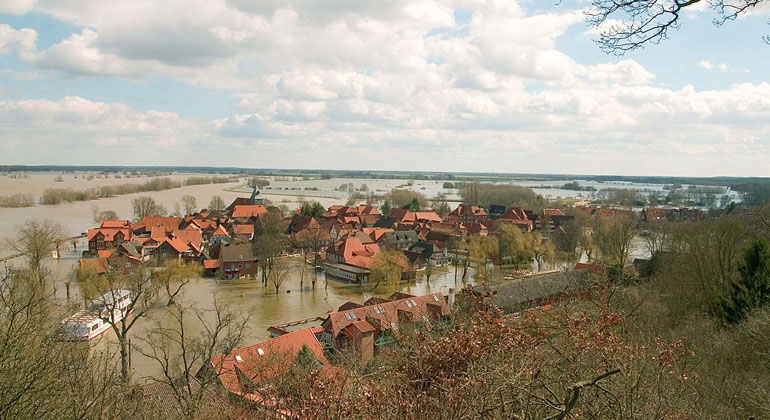Flood data from 500 years: Rivers and climate change in Europe
A major international research project led by TU Wien (Vienna) shows for the first time that flooding characteristics in recent decades are unlike those of previous centuries.
Overflowing rivers can cause enormous problems: Worldwide, the annual damage caused by river floods is estimated at over 100 billion dollars – and it continues to rise. To date it has been unclear whether Europe is currently in a flood-rich period from a long-term perspective.
Austrian flood expert Prof. Günter Blöschl from TU Wien, opens an external URL in a new window (Vienna) has led a large international study involving a total of 34 research groups that provides clear evidence that the past three decades were among the most flood-rich periods in Europe during the past 500 years, and that this period differs from others in terms of its extent, air temperatures and flood seasonality. Compared to the past, floods tend to be larger in many places, the timing has shifted and the relationship between flood occurrence and air temperatures has reversed. In the past, floods tended to occur more frequently in cold phases, while today, global warming is one of the main drivers of their increase. The results of the study have now been published in “Nature, opens an external URL in a new window” magazine.
Historical data from half a millennium
“From our previous research, we already knew how climate change has affected Europe’s floods in the past 50 years,” says Alberto Viglione, opens an external URL in a new window from the Politecnico di Torino, one of the key authors of the publication. “For forecasts of the next decades, however, it is also important to understand whether this is a completely new situation or whether this is just a repetition of something that has already occurred. So far, the available data had not been sufficient to ascertain whether this is the case or not. We have examined this question in great detail and can now say with confidence: Yes, flooding characteristics in recent decades are unlike those of the previous centuries.”
For the study, tens of thousands of historical documents containing contemporary flood reports from the period 1500 to 2016 were analysed. The TU Wien team has worked with historians from all over Europe. “The particular challenge of this study consisted in making the very different texts of the different centuries and different cultural regions comparable,” explains Andrea Kiss, opens an external URL in a new window from the Vienna University of Technology, researcher and historian herself, and one of the key authors of the publication. “We managed to achieve this comparability by putting all the texts in their respective historical contexts with painstaking attention to detail.”
Formerly cold, now warm: River floods now function differently
The data analysis identified nine flood-rich periods and associated regions. Among the most notable periods were 1560–1580 (western and central Europe), 1760–1800 (most of Europe), 1840–1870 (western and southern Europe) and 1990–2016 (western and central Europe). Comparisons with air temperature reconstructions showed that these historical flood periods were substantially cooler than intervening phases.
“This finding seems to contradict the observation that, in some areas such as in the northwest of Europe, the recent warmer climate is aligned with larger floods,” says Günter Blöschl. “Our study shows for the first time that the underlying mechanisms have changed: While, in the past, floods have occurred more frequently under colder conditions, the opposite is the case now. The hydrological conditions of the present are very different from those in the past.”
The timing of the floods within the year has also changed. Previously, 41% of Central European floods occurred in the summer, compared to 55% today. These shifts are related to changes in precipitation, evaporation and snowmelt and are an important indicator for distinguishing the role of climate change from that of other controls such as deforestation and river management.
These findings have been made possible by a new data base compiled by the study authors that includes the exact dating of almost all flood events reported by written sources. So far, one had to often rely on other, less precise sources of information, such as lake sediments. It is the first study worldwide to evaluate historical flood periods for an entire continent in such detail.
Better data – better forecasts
Because of the shift in the flood generating mechanisms, Günter Blöschl advocates the use of tools for flood-risk assessment that capture the physical processes involved, and management strategies that can incorporate the recent changes in risk. “Regardless of the necessary efforts of climate change mitigation, we will see the effects of these changes in the coming decades,” says Blöschl. “Flood management must adapt to these new realities.”
- Original publication: G. Blöschl et al., Current European flood-rich period exceptional compared with past 500 years; Nature (2020), DOI: 10.1038/s41586-020-2478-3










